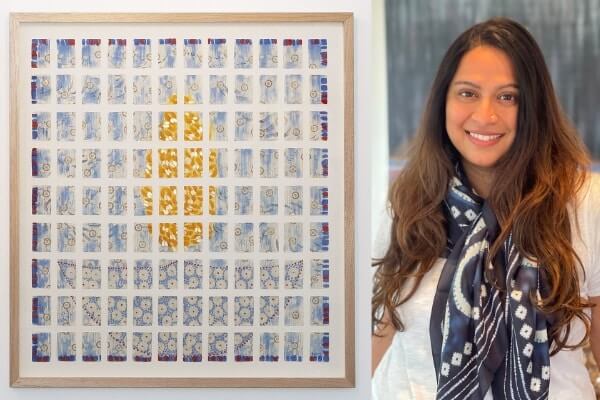In a wonderfully different exhibition of Australian native flowers that opened this week, Sydney-based artist Gauri Torgalkar weaves in a familiar Indian theme, Diwali.
Or perhaps we could word that the other way round.
In a refreshingly different exhibition of Diwali art, Gauri Torgalkar introduces a new theme, Australian native flowers.
Either way, Gauri’s latest installation at Peacock Galleries in Auburn, Diwali Bloom, is sure to bring a smile to your face as it illuminates new connections between familiar constructs.
“Diwali Bloom reimagines Australian native flora from the local Cumberland Plain Woodlands in a format inspired by Indian concepts,” Gauri told Indian Link. “It is a part of Cumberland City Council’s Diwali celebrations this year.”
A striking piece at the exhibition is a dual panel of miniature paintings, each a collection of 108 cards. Look closely, and you’ll see the design is based on Australian natives. Step back, and you’ll see the cards are arranged to form a deep (diya) in one case, and hands folded in a namaste in the second. Together, they make up Pushpa Deep and Pushpa Namaskar – an Australian floral tribute to Diwali.
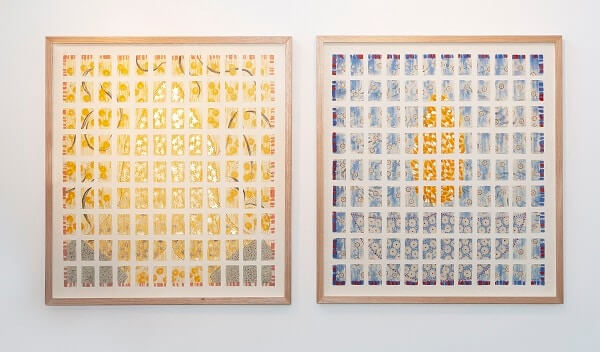
Is it the flowers that leap out to you, or is it the deep and the namaskar?
Is it the Japanese handmade paper, or the Indian artistic technique of block printing?
Perhaps it is that number, 108, loaded with spiritual symbolism, that first draws your attention.
“Your own unique perspective will form the basis of how you look at these works,” Gauri explained.
Your interest sufficiently piqued, you move to the other works, large paper-lanterns, so common during Diwali in Gauri’s hometown Mumbai. Signifying the light that will illumine our society and our own inner selves, the lanterns here also bring attention to the natural surrounds in Gauri’s (other) hometown Sydney – flowers significant to the local Indigenous people, many of them currently endangered species.
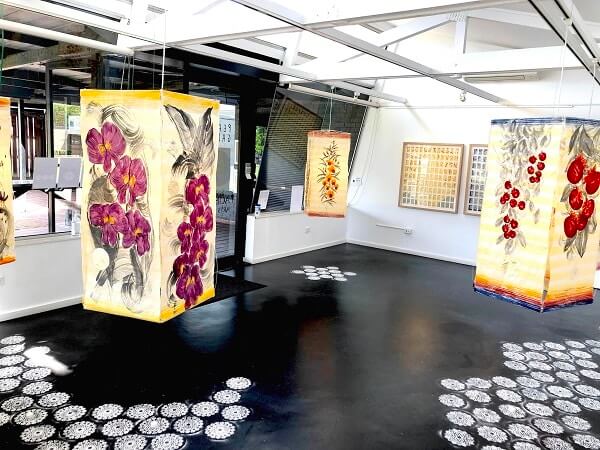
The five paper-lanterns, each four-sided, are home to twenty different paintings.
“I am enthralled by the Australian landscape, plant life especially,” Gauri revealed. “It’s been fascinating, learning about the trees, the leaves, the rare flowers.”
As she broached the idea of painting native flora with Michael Brown, Gallery Director and Cultural Services Coordinator at Cumberland Council, he suggested an exhibition to coincide with Diwali. The seeds were sown for Diwali Bloom.
Building cultural associations is a frequent theme for artists with hyphenated identities. ‘Strange familiar’ has been a recurring idea in Gauri Torgalkar’s own work, and the joy of unpacking it in this instance is gratifying.
Pushpa Deep and Pushpa Namaskar are Gestaltian in many ways – suggestive of the disparate, perhaps even contrasting, bits and pieces of us that make us who we are. As a whole, we are greater than the sum of our parts – Indian and Australian.
The Indian aesthetic is unmistakable in the paper lanterns.
“The sari is an eternal inspiration,” Gauri laughed. “I reference it here in the handloom feel, the frame borders, and the gold foil.”
As for the colours of the flowers, they could well be Bollywood bold. Check out the crimson red of the nodding saltbush, the flourescent pink and orange of the flame pea, the deep purple of the sarsaparilla, the bright yellow and red of the creeping bossiaea, the blue of the dianella or flax lily, the gentle yellow of the hickory wattle pompoms, and the soothing freshness of the white star creeper.
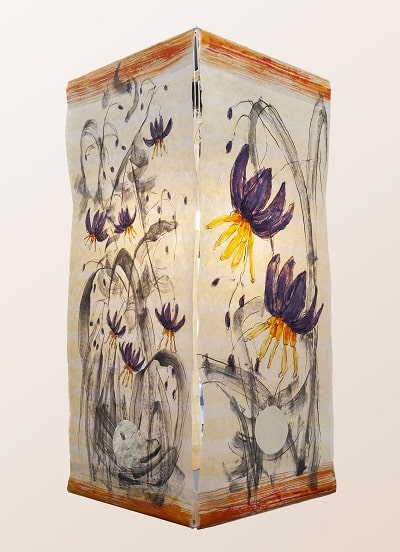
The flower early nancy, seen in Pushpa Deep, has probably always reminded you of the Indian block print: the white-petalled flower has a distinct purple ring stamped cheekily in the middle.
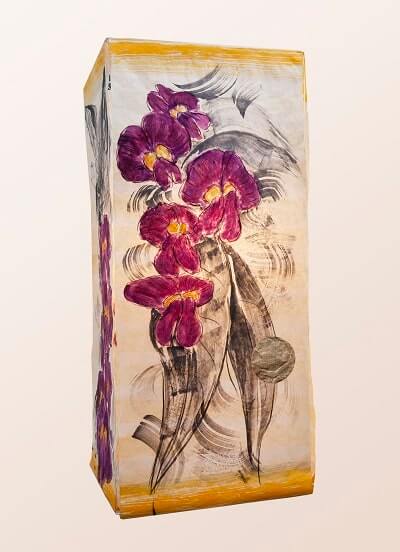
Diwali Bloom adds to Gauri’s growing body of work as she continues to grapple with existential conundrums in the migrant mind.
How ‘Indian’ are we, for example? Have we become ‘Australian’? Where is ‘home’?
That old adage – you can take an Indian out of India but you can never take India out of an Indian – may well be correct, but perhaps another truth is that the Australian within us now is well and truly here to stay.
Gauri incorporates a third element in Diwali Bloom, that quintessential floor decoration we know as rangolis, as an exercise in reverse assimilation.
“The rangolis were intended for community participation,” Gauri revealed. “The idea was to have visitors add to the rangolis already on the floor, with powder provided, so that we would end up with a giant community-created rangoli. But alas it was not to be, thanks to lockdown.”
Yet the rangoli activity has now taken on another form. “You can DIY, with kits we have made available at Council libraries. We’ve also created a video you can follow.”
Diwali Bloom is supported by the NSW Government through Create NSW Small Projects Grant and by Cumberland City Council through additional funding and in-kind support.
View a virtual experience of the installation here



